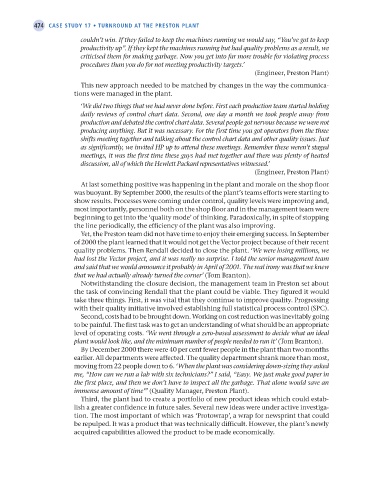Page 499 - Operations Strategy
P. 499
474 case study 17 • turnround at the Preston Plant
couldn’t win. If they failed to keep the machines running we would say, “You’ve got to keep
productivity up”. If they kept the machines running but had quality problems as a result, we
criticised them for making garbage. Now you get into far more trouble for violating process
procedures than you do for not meeting productivity targets.’
(Engineer, Preston Plant)
This new approach needed to be matched by changes in the way the communica-
tions were managed in the plant.
‘We did two things that we had never done before. First each production team started holding
daily reviews of control chart data. Second, one day a month we took people away from
production and debated the control chart data. Several people got nervous because we were not
producing anything. But it was necessary. For the first time you got operators from the three
shifts meeting together and talking about the control chart data and other quality issues. Just
as significantly, we invited HP up to attend these meetings. Remember these weren’t staged
meetings, it was the first time these guys had met together and there was plenty of heated
discussion, all of which the Hewlett Packard representatives witnessed.’
(Engineer, Preston Plant)
At last something positive was happening in the plant and morale on the shop floor
was buoyant. By September 2000, the results of the plant’s teams efforts were starting to
show results. Processes were coming under control, quality levels were improving and,
most importantly, personnel both on the shop floor and in the management team were
beginning to get into the ‘quality mode’ of thinking. Paradoxically, in spite of stopping
the line periodically, the efficiency of the plant was also improving.
Yet, the Preston team did not have time to enjoy their emerging success. In September
of 2000 the plant learned that it would not get the Vector project because of their recent
quality problems. Then Rendall decided to close the plant. ‘We were losing millions, we
had lost the Vector project, and it was really no surprise. I told the senior management team
and said that we would announce it probably in April of 2001. The real irony was that we knew
that we had actually already turned the corner’ (Tom Branton).
Notwithstanding the closure decision, the management team in Preston set about
the task of convincing Rendall that the plant could be viable. They figured it would
take three things. First, it was vital that they continue to improve quality. Progressing
with their quality initiative involved establishing full statistical process control (SPC).
Second, costs had to be brought down. Working on cost reduction was inevitably going
to be painful. The first task was to get an understanding of what should be an appropriate
level of operating costs. ‘We went through a zero-based assessment to decide what an ideal
plant would look like, and the minimum number of people needed to run it’ (Tom Branton).
By December 2000 there were 40 per cent fewer people in the plant than two months
earlier. All departments were affected. The quality department shrank more than most,
moving from 22 people down to 6. ‘When the plant was considering down-sizing they asked
me, “How can we run a lab with six technicians?” I said, “Easy. We just make good paper in
the first place, and then we don’t have to inspect all the garbage. That alone would save an
immense amount of time”’ (Quality Manager, Preston Plant).
Third, the plant had to create a portfolio of new product ideas which could estab-
lish a greater confidence in future sales. Several new ideas were under active investiga-
tion. The most important of which was ‘Protowrap’, a wrap for newsprint that could
be repulped. It was a product that was technically difficult. However, the plant’s newly
acquired capabilities allowed the product to be made economically.
Z17 Operations Strategy 62492.indd 474 02/03/2017 14:01

